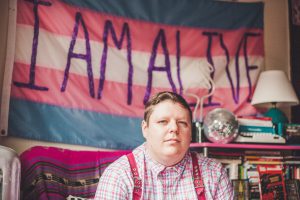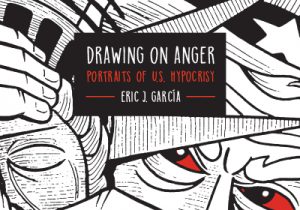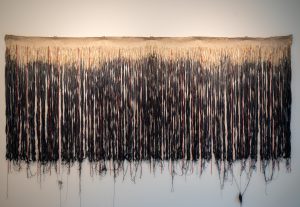I watch people warn each other about which Chicago neighborhoods they shouldn’t go to, which streets they shouldn’t live past – all the time. Neighborhoods that are mostly white or halfway gentrified are safe, they tell each other. The neighborhoods I grew up in or live in now, communities of color, are cordoned off as unsafe. I watch people pass on patterns molded by the history of segregation in this city, unaware of the ugliness of what they are actually doing, patterns they carry with them into what they view as this city’s culture. If they’ve never been to certain parts of the city, our aesthetics are alien. But it is impossible to know Chicago art if you don’t know Chicago past the parts that have been marked safe for you. And that is the genius of a show like The Subject is Chicago: People, Places, Possibilities. It challenges passed on patterns and notions of what makes up the Chicago art scene by gathering artists from each of the city’s 50 wards and introducing viewers to artists beyond those few that have been marked safe for them.
And so in a city so unconsciously conscious about who belongs where, it is no surprise to see someone question the value of a space as a result of a show erasing those passed on patterns. In this city, I know what it’s like to have people flee a space over fears my simple presence will lower their values. For Mexicans and Mexican Americans our presence and certainly our aesthetics are already political in this country, regardless of what we may have to say. I am reminded of Sandra Cisneros painting her house purple and having to defend her Mexican aesthetics against complaining neighbors and a historic review board that refused to acknowledge the history of those very aesthetics – in San Antonio of all goddamned places. We Mexicans are all too familiar with what is actually being said when we hear coded fretting over the “cultural identity” of a place, whether it be a gallery, a neighborhood, a city, or a country – especially now. I had the opportunity to chat with Yvette Mayorga, one of the artists included in The Subject is Chicago: People, Places, Possibilities, to unpack reactions to Mexican aesthetics in Chicago, the value of political art in the Trump era, and the beautiful Mexican art of telling people to go fuck themselves.
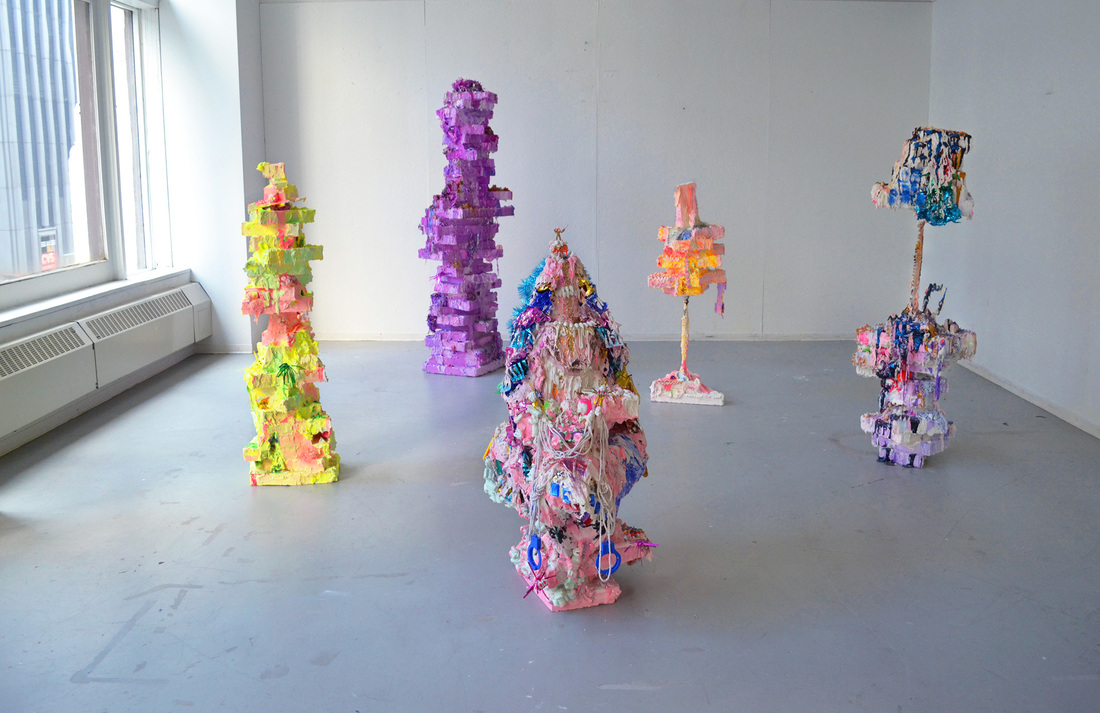
Jennifer Patiño Cervantes: As someone whose family immigrated here from Mexico myself, watching Really Safe in my Room in America– seeing paletas and dulces and piñatas, all the things that I associate with my childhood and my family, intercut with images of violence on the border causes a very visceral reaction in me. I say all this to be transparent since I don’t believe in assuming viewers can be neutral. I connect very personally with your imagery and I wonder whether you find this is often the case or whether you encounter resistance to it from people who don’t connect as much. In our current political climate, who do you find yourself envisioning as your viewer?
Yvette Mayorga: I have encountered visceral reactions from POC and non-POC. It has been interesting to see similar reactions between people who don’t have a particular tie to the history of immigrating to the U.S. but have an empathetic response to my work. I believe that people can react to death, violence, and celebration as a cross-cultural reaction. I have also experienced resistance to my work that has been displayed by patrons walking up to the work, then realizing it’s politically unpacking issues of immigration, turning their backs and walking away.
During this time in America I consider everyone my viewer, especially the individuals who feel uncomfortable facing political work addressing border issues. The video, Really Safe in my Room in America, was created in 2015 as a response to my family’s history and the media’s response to violence against the undocumented and violence on the border. The video was created when I came across personal photographs of myself in my archives. I used my personal photographs and layered them on top of imagery of the border as a way to critique my safety in being born in America and never having to cross the treacherous border like my father did in the early 70’s. The video contemplates my “safety” and leisure in being able to contemplate my body while violence is occurring on site of the border. I didn’t realize the video would feel so timely and pertinent in 2017, nor could I have fathomed the idea of our current elected president being a reality. Due to our current state I want young WOC to see my work and be able to feel like they can relate to it, or feel like they can show work in institutions that critique the system of oppression.
JPC: There was a review of The Subject is Chicago: People, Places, Possibilities in Third Coast Review that came off as bigoted with regards to your work. In the context of a showcase of artists from all of the city’s wards, which itself seems like an attempt to counteract the racist perception that there is no art in certain parts of Chicago, the reviewer very tone-deafly treated your work, which deals with immigration, borders, and being made to feel like Mexicans/Mexican Americans don’t belong – as though your work didn’t belong in a show about Chicago. Pearls were clutched about the “cultural identity” of the city. Meanwhile, your aesthetics manage to be transnational while also being reminiscent of corner stores and bakeries in various Chicago neighborhoods. Do you find that there are echoes of the way you relate to the border with your experience in Chicago’s art scene and in the city itself? If so, what and how do you deal with them?
YM: The negative review from Third Coast Review, was shocking for a minute, but ultimately really reminded me of why I make politically charged work. I believe the writer was left feeling upset and uncomfortable that I could voice such a politically charged statement in an institution like the Chicago Cultural Center and have it be deemed as “art” and more specifically “Chicago art.” Her response was very telling of the present day resistance towards giving voice to bodies that are marginalized. It felt like the white cannon had stricken again. The review lacked empathy, critical art history pedagogy and overall socioeconomic understanding. It felt like an insult to brown bodies, but also a glimpse at what skewed views the writer has on the history of violence in the U.S. and Chicago. The writer addressed political work as being simplified to a sentence: “identifying a problem without offering a solution is not commentary, it’s merely complaining.” If identifying a problem without offering a solution is merely complaining, then the fight for women in the arts was as simple as complaining. The review was violently summed up by offering a list of other artists who are making ethos work in Chicago, and named 5 white men out of the 7 artists.
Yes, there are echoes in the way I relate the border with my experience in Chicago. Living and working in Pilsen, the neighborhood my dad lived in when he first moved to Chicago in the ‘70s has impacted me. Being able to grow as an individual and artist in the community of Pilsen has influenced my work. I’m constantly surrounded by my Mexican American culture while also being surrounded by my community of cultural makers. I am influenced by the store windows, as these gated views on American consumerism and its impact in the immigrant community. How collecting objects and displaying them can have a cultural impact or display of attaining the American Dream. I also think the current state of Pilsen while it is facing gentrification has created an urgency towards continuing to find a way of communicating my cultural iconography in my work without making it a commodity. It’s a moment where I walk down the street and see businesses being displaced or new developments in the process and it creates a sense of cultural loss. The displacement is another layer of the violence on the marginalized. Also having the opportunity to be an educator in Pilsen has been a large influence in my work, showing youth art as a means of resistance is urgent during this time in America.
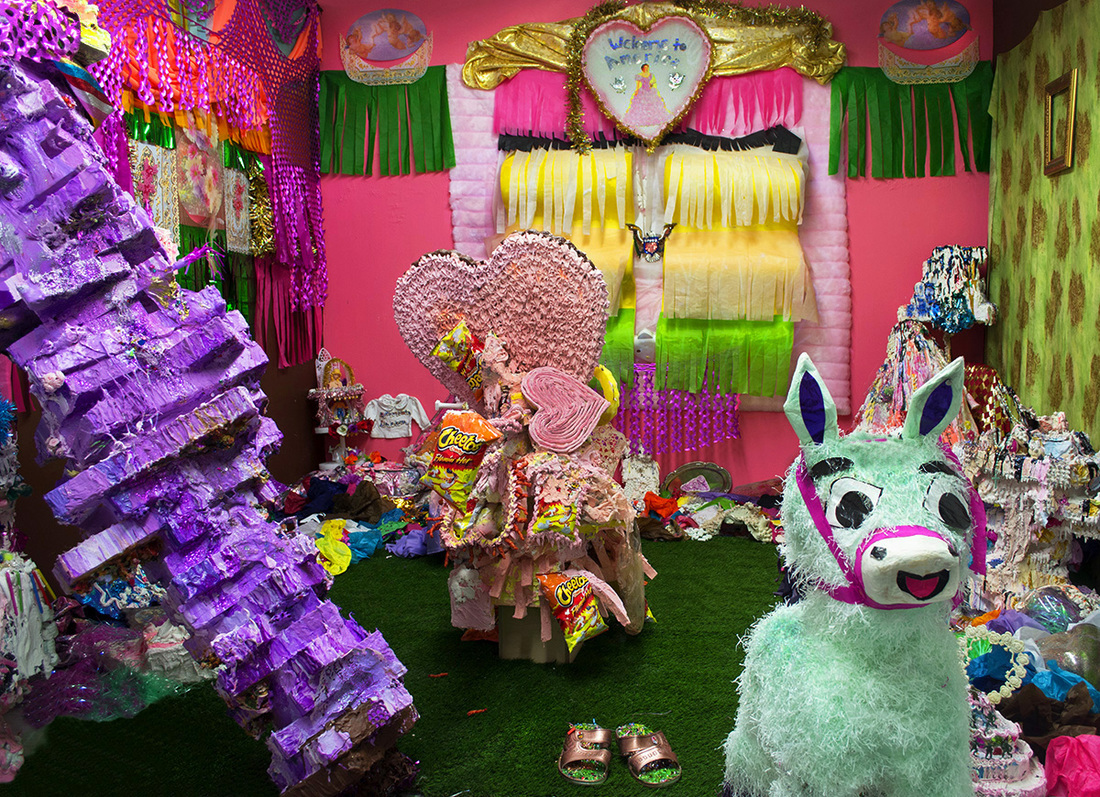
JPC: There is something brilliantly gendered about architectural elements recreated in pastel piping, a false comfort that sets us up to be shocked. And then you emblazon “Go Fuck Yourself with a Cactus” in feminine letters across Donald Trump’s face. There’s such a beautiful Mexican art to telling people to go fuck themselves. (I’m convinced we’re the best at it in all the world.) It can be such a compliment when people take offense – do you ever view it as a compliment? In the context of gendered imagery in the installation and video, the use of the bed frame as border in particular, is this a critique of comments made by Trump about Mexicans being rapists while being accused himself by various women of sexual assault? What do you feel the role is of political art in the Trump era and have you ever felt pressured to change your aesthetics to get the message across?
YM: I think of the word “Chingar,” or “Chignonx,” as such a violent word that has been taken to express power within Mexican American womxn. Yes, I believe we are the best at telling people to go fuck themselves – it’s in our nature to politicize words and revert their meanings to create a source of power. I do believe it is a compliment when people take offense to my politicized work. Due to its content, the offense becomes a marker that the work is doing what it is intended to do. The bedroom/bed frame in the video is a response to Trump’s comment on Mexicans being rapists while also displaying the spaces in the home of immigrants. The bed frame exists as a counter while also depicting how spaces in the home can be political.
I think the role of political art in the Trump era is to continue to tell the truth, to surpass assumptions/ideologies/racism by creating work that is personal and honest. I have never felt pressured to change my aesthetics to continue to talk about issues of immigration in my work. I began making work about immigration in 2013 and have continued my journey to unpack the idea of the American dream. As of lately I hear a lot of people tell me my work is timely, but I have been creating this work for the past 4 years pre-Trump era. The issues of displacement and immigration have been surrounding me since I was a child. I think believing such work is timely is continuing to ignore the fact that the marginalized experience these issues on a daily basis while those not affected can calmly rest their head at night. Having a president that has created chaos and now has opened dialogue on issues of immigration has created a unanimous platform where everyone feels alert and decisive, but the reality is that this is a continuation of a history that has been occurring well before.
JPC: Have you faced many barriers in Chicago’s art scene? As displacement happens in Pilsen, have you felt like the work you do as a professional artist and as an educator is less welcome? And what advice do you have for artists of color facing barriers?
YM: I am grateful to say I have not faced any barriers in Chicago’s art scene that I have not been able to overcome. I have faced issues regarding educating audiences on issues of immigration who either want to commodify my work or other it. I think being a part of Pilsen’s community has given me the support of POC artists and cultural makers necessary to critique the system together and support each other. Living and working in Pilsen is complicated, personally for me being an educator and working with my community is integral to living in the community. As a daughter of immigrants who used to live in Little Village and Pilsen, I have a connection to the neighborhood but I also understand that as someone who pursued education I have a responsibility to be self-aware of my position.
My advice for artists of color facing barriers is to continue to make work that feels true and honest to themselves, to not stray away from making work about identity because the white cube may view it as less than, to pushback against gender norms/racism/marginalization by using their voice to say something in art. To make art that is about the most essential part of yourself without worrying whether or not colleagues will understand it or attempt to “other” it, and if you want to be excessive and say “Go fuck yourself with a cactus,” then do it!
Jennifer Patiño Cervantes was born on the Southwest Side of Chicago and her family is from Mexico. She is a freelance writer, poet, essayist, and Director of Development for Sixty Inches From Center. She graduated from Columbia College with a degree in Art History and double minors in Poetry and Latino/Hispanic Studies. She is a lover of Chicago’s Visual Arts and Literary communities and lives to explore the links between them.
Featured Image: Really Safe in my Room in America, Yvette Mayorga, 2017. Image courtesy of the artist.



